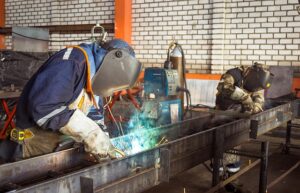Know the top five Welding safety hazards and precautions
 Welding process is a common process used in most of the engineering industries in the World. If you are a Welder, supervisor or a manager, be aware of the welding safety hazards and the precautions that should take in order to avoid related occupational workplace incidents. This blog on welding safety hazards and precautions talks about the common hazards in welding and ways to prevent them. And, this blog is not exhaustive by any means, but attempts to provide the basic knowledge needed for safety champions.
Welding process is a common process used in most of the engineering industries in the World. If you are a Welder, supervisor or a manager, be aware of the welding safety hazards and the precautions that should take in order to avoid related occupational workplace incidents. This blog on welding safety hazards and precautions talks about the common hazards in welding and ways to prevent them. And, this blog is not exhaustive by any means, but attempts to provide the basic knowledge needed for safety champions.
Welding Hazard 1 – Welding fumes
The fumes released from welding operation generally contains compound of metal oxide, silicates and fluorides emanating from the base metal and the consumables used (such as welding electrode). These fumes are harmful for the human body and will affect the nervous system and respiratory system among other health problems.
So, to prevent the health hazards from toxic welding fumes,
- The welders should not work in confined spaces but in sufficiently ventilated places with good exhaust control system.
- Use weld smoke collectors, ducts and exhaust hoods to prevent such hazards.
- Welders must keep their heads away from the fumes while welding.
- High level of fumes call for welders to wear approved and good quality welding respirators. There is a good range of reusable welding respirators available in the market that can protect from fumes while ensuring proper breathing.
- It is a good practice to clean the weld to clear the paint or other coatings prior to welding.
Welding Hazard 2 – radiation and high intensity light / sparks
Harmful radiation from ultra-violet rays and Infrared rays, high intensity light with sparks and debris can damage the eyes of the welder and cause burns. Hence to prevent these hazards, the welders must always wear face shields, welding helmets with safety goggles and side shields so that flash burns are avoided.
Welding Hazard 3 – Electric shock
When welder comes in contact with two metal objects with high voltage between them, it results in electric shock that can lead to severe injuries and fatalities. Welding process generates voltages between 20 and 100 volts. Secondary voltage shock is a good example encountered during arc welding operation where even 50 volts can lead to fatality. This hazard can be prevented by wearing a pair of good quality welding gloves with well insulated sheaths that prevents electricity to pass through it. The welders should not touch the electrode or the metal parts with bare hands or gloves not suitable for welding purpose or with wet clothing. Wearing welding footwear / boots with electrical hazard insulation is also helpful.
Welding Hazard 4 – Fire or explosion
High temperatures of thousands of degree Celsius (up to 5500 deg. C) in Welding operation pose fire as well as explosion hazards. The heat, spark and the spatter of the welding arc may reach up to 35 feet away from the welding area. The hazards will materialize if these spatter and heat come in contact with flammable liquids and gases stored near the area causing fire and explosion.
Therefore, to prevent the fire or explosion hazards, prior to welding the welder or the supervisor has to ensure that no flammable materials are stored in the welding area and has to mandatorily include this in the Hot work permit. There must also be easy access of the welder to the fire alarm point. Fire fighting equipment must be ensured in case of fire. The area must also be declared as a No smoking zone.
Welding Hazard 5 – Use of wrong or unsuitable PPE
While it is true that using the right suitable personal protective equipment (PPE) in welding operation can protect the welder from welding hazards, it is also true that use of unsuitable or wrong or insufficient PPE in welding operation can be dangerous resulting in injuries and fatalities to the welder. PPE must be purchased after a good study of its specifications and suitability to welding apart from other business terms.
Examples of right PPE for welding are:
- For the protection of the welder from the radiant energy, flying sparks, and spatter, wearing a Welding helmet with filter lens and cover plate that meets the ANSI Z87.1 standard or equivalent National / International standards
- When you choose Welding gloves, it must be kept in mind that these are made with leather, and is insulated, cut and scratch resistant and can protect the welder’s hands from burns, sparks, heat and electric shock
Blog written by: Sudhir GK, Management Consultant
Do you want to implement and get certified to the ISO 45001 occupational health and safety management system standard? Click here
If you are looking for articles like the above on welding safety hazards and precautions please visit our blog regularly.
